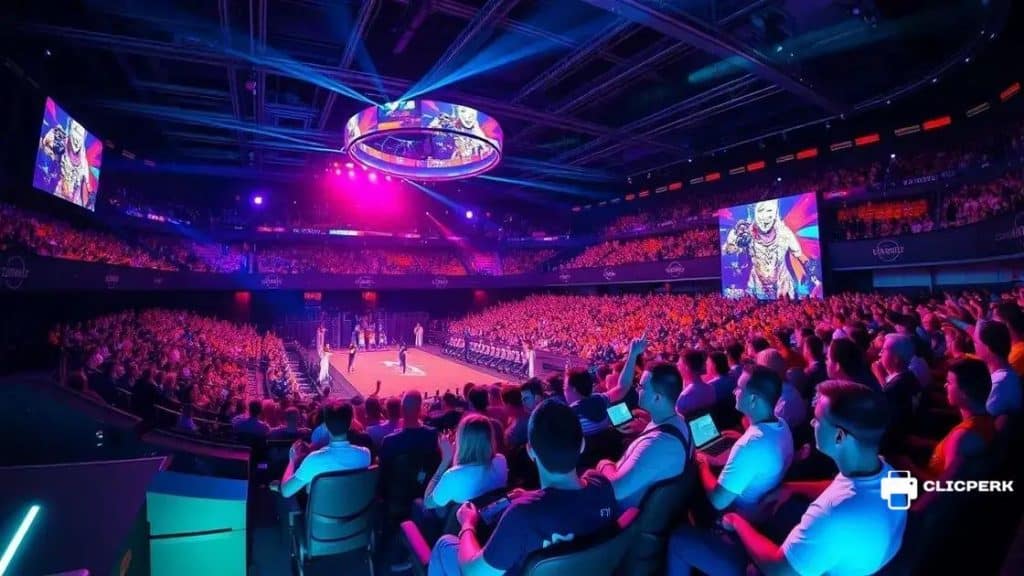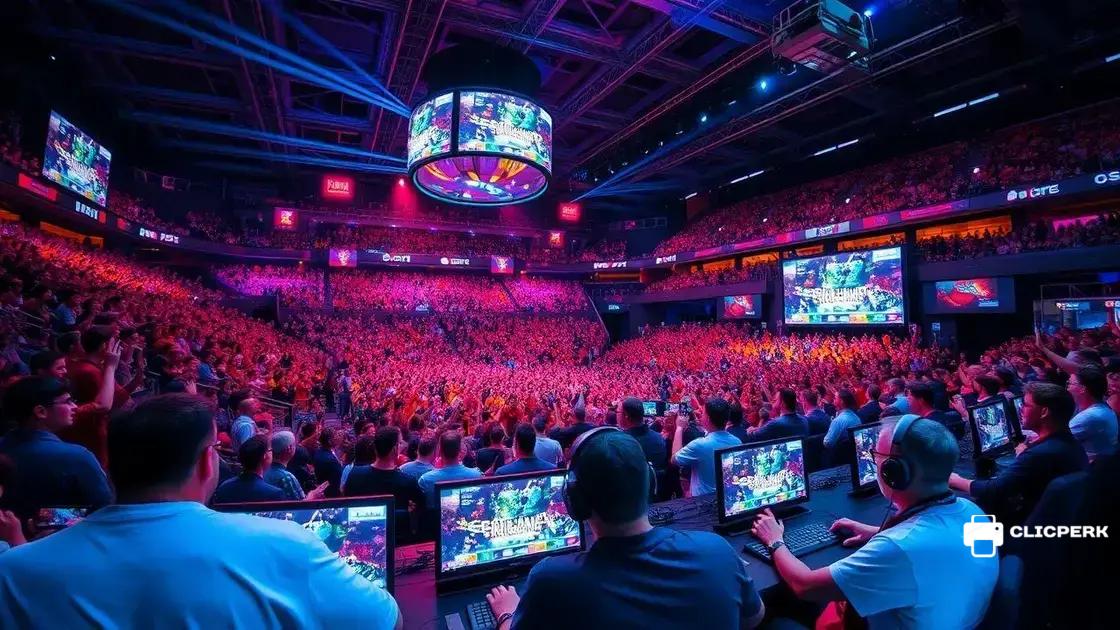The evolution of e-sports: from hobby to professional sport

Anúncios
The evolution of e-sports has transformed gaming from a hobby into a professional industry, driven by technological advancements, increased sponsorship, and the growing popularity of competitive tournaments and streaming platforms.
The evolution of e-sports has been nothing short of remarkable. What started as casual gaming has grown into a global phenomenon, attracting millions of fans and professional players alike. Have you ever wondered how this transformation happened?
Anúncios
The beginnings of e-sports
The beginnings of e-sports trace back to the early days of video gaming. In the 1970s and 1980s, arcade games were hugely popular, and gamers often competed for high scores. This friendly competition laid the groundwork for what would eventually evolve into formal e-sports.
As technology advanced, home gaming consoles became more widespread, and multiplayer games emerged. These allowed players to compete against each other from the comfort of their homes. Game titles like ‘Street Fighter’ and ‘Doom’ sparked early e-sport tournaments. Players worldwide gathered to showcase their skills, marking the start of a new competitive landscape.
Key Events in the Early Years
Several key events helped shape the early e-sports scene:
Anúncios
- The first documented video game competition was held at Stanford University in 1972, featuring the game ‘Spacewar!’.
- The 1980s saw the rise of arcade tournaments, where players competed for cash prizes and recognition.
- The formation of organizations like the International eSport Federation in 2008 signified a move toward formal structure in the community.
As the 1990s rolled in, the advent of the internet further fueled competition. Gamers could connect globally, creating communities and rivalries. Dedicated gaming magazines and online forums emerged, giving enthusiasts a platform to discuss strategies and upcoming events. This fostered a culture of competition that would grow exponentially in the following decades.
The Birth of Professional Gaming
With this increased connectivity, professional gaming began to take shape. Players could form teams and compete in leagues. The 1997 Red Annihilation tournament, featuring ‘Quake’, is often cited as one of the first major e-sports events, paving the way for larger competitions.
As gaming continued to evolve, so did the spectatorship. Fans began watching these competitions, both online and in-person, leading to the emergence of streaming platforms. Today, e-sports events fill stadiums worldwide, showcasing the incredible growth from those humble beginnings.
Key moments that shaped competitive gaming
Throughout the history of gaming, certain key moments have significantly shaped the world of competitive gaming. These milestones not only paved the way for modern e-sports but also inspired countless players and fans.
One major turning point came in 1997 with the Red Annihilation tournament, which played ‘Quake’. This event is often regarded as the first major e-sports competition and attracted players from around the globe. It captured the attention of both the gaming community and the media, showcasing the potential for competitive play.
The Rise of Organized Tournaments
Organized tournaments became a cornerstone of competitive gaming in the early 2000s. Events such as the World Cyber Games and the Electronic Sports World Cup provided platforms for top players to compete on international stages.
- World Cyber Games launched in 2000, uniting players from various countries.
- The Electronic Sports World Cup began in 2003, featuring multiple game titles.
- These tournaments attracted sponsorships and media coverage, fueling the e-sports boom.
In 2011, the launch of streaming platforms like Twitch revolutionized how fans accessed and interacted with competitive gaming. Gamers could now broadcast their gameplay live, allowing viewers to watch matches in real-time. This sparked a new era where popular gamers became stars and drew massive audiences.
Major Game Releases
Several game releases also contributed to the competitive gaming landscape. Titles like League of Legends and Dota 2 introduced complex strategies and team dynamics, leading to an increase in organized tournaments.
These games inspired professional leagues, bringing together teams to compete for significant prize pools. In 2018, the International for Dota 2 offered over $25 million in prize money, highlighting the incredible growth of competitive gaming.
The rise of professional tournaments

The rise of professional tournaments marked a significant turning point in the world of gaming. As competitive play gained popularity, players began to form teams and participate in organized competitions. These tournaments offered a platform for gamers to showcase their skills on a larger stage.
Initially, these events were small and local. However, as interest grew, tournament organizers began to host larger competitions with significant cash prizes. The introduction of sponsorships further elevated these events, drawing in more players and fans alike.
The Evolution of Tournament Structure
Early tournaments were often informal and lacked standard rules. Greater interest led to the establishment of formal structures. Organizations like ESL (Electronic Sports League) and MLG (Major League Gaming) emerged, creating professional leagues and formats to increase competitiveness.
- ESL became one of the largest e-sports tournament organizers, providing platforms for various game titles.
- MLG introduced tournaments that drew thousands of participants and spectators, paving the way for future events.
- These organizations also established ranking systems, ensuring fair play and promoting growth in competitive gaming.
The first official e-sports tournament was the Cyberathlete Professional League (CPL) in 2000. This event featured games like ‘Quake III Arena’ and set the stage for many tournaments to follow.
Expansion into Major Events
As time went on, tournaments evolved into massive events. Title championships like the League of Legends World Championship and The International for Dota 2 showcased the talent and dedication of top players worldwide. The prize pools for these events reach millions, attracting professional players from every corner of the globe.
This growth also led to increased media coverage. Streaming platforms such as Twitch made it easier for fans to watch live tournaments, further popularizing e-sports. Fans can now follow their favorite players and teams, turning competitive gaming into a mainstream phenomenon.
Influence of technology on e-sports
The influence of technology on e-sports has been profound, reshaping how games are played, viewed, and experienced. Advances in technology have not only enhanced gameplay but have also expanded the competitive gaming landscape.
Initially, the quality of graphics and processing power played a crucial role in e-sports growth. Early games had limited visuals and functionality. As hardware improved, games became more complex and visually stunning, attracting a larger player base and audience.
Streaming and Broadcasting
The rise of streaming platforms like Twitch has transformed how fans engage with e-sports. Gamers can easily broadcast their gameplay to millions, creating a global community. This accessibility encourages new players to enter the scene while allowing established gamers to reach broader audiences.
- Live streaming brings fans closer to the action, fostering interaction through chat features.
- Viewers can watch tournaments live from anywhere, increasing engagement.
- The ability to stream gameplay has turned regular gamers into influencers and content creators.
Moreover, technological innovations in broadcasting have improved the presentation of e-sports events. Enhanced graphics, real-time statistics, and expert commentary have made watching e-sports more enjoyable. High-definition broadcasts allow viewers to see every detail, immersing them in the experience.
Hardware and Game Development
Advanced hardware has also contributed significantly to competitive gaming. Professional players often use high-performance gaming rigs and peripherals to gain an edge. Features like customizable gaming mice and mechanical keyboards offer precision and speed, which are essential in high-stakes matches.
Additionally, game developers continuously update titles to improve balance and gameplay. Regular patches and updates keep the competitive scene fresh, ensuring that players adapt and evolve their strategies. Innovations in artificial intelligence and machine learning also contribute to creating more realistic environments, further enhancing player experience.
Future trends in the e-sports industry
The future trends in the e-sports industry promise exciting developments that could reshape the landscape even further. As technology and community engagement evolve, the way we experience e-sports is likely to change dramatically.
One significant trend is the increasing integration of virtual reality (VR) and augmented reality (AR) in gaming. These technologies can create immersive experiences, allowing fans to feel like they are part of the action. Imagine watching a tournament and having the ability to view the players’ perspectives while also exploring the game environment.
Increased Sponsorship and Investment
Furthermore, sponsorships and investments in e-sports are on the rise. Major brands are beginning to recognize the value of associating with e-sports, leading to larger prize pools and better production quality for events. This influx of funding can help develop more structured leagues and tournaments.
- Brands like American Express and Pepsi have already begun investing in e-sports, reflecting its mainstream acceptance.
- With bigger budgets, event organizers can improve venue experiences and attract more viewers.
- As sponsorships grow, players can receive better support, enhancing their training and competitive environments.
Another key trend is the growth of mobile gaming in e-sports. With the rise of smartphones, games designed for mobile platforms are becoming more popular in the competitive scene. Games like Mobile Legends and PUBG Mobile are already witnessing large tournaments, demonstrating that competitive gaming is not limited to traditional PCs or consoles.
Community Engagement Through Social Media
The role of social media is also becoming increasingly important in the e-sports community. Platforms like Twitch and YouTube allow players to interact with fans, offering insights into their training and gameplay. This level of engagement helps build a dedicated fan base, which is essential for the longevity of e-sports.
Finally, as regulatory bodies begin to consider e-sports more seriously, we may see established rules and guidelines that promote fair play, enhance safety, and protect players’ rights. This professionalization will help legitimize e-sports in the eyes of traditional sports organizations.
FAQ – Frequently Asked Questions about E-Sports
How has technology impacted the growth of e-sports?
Technology has enhanced graphics, improved gameplay, and facilitated live streaming, making e-sports more accessible and engaging for audiences.
What are the future trends in e-sports?
Future trends include the rise of virtual reality (VR) gaming, increased sponsorship, and the growth of mobile gaming as competitive platforms.
Why are professional tournaments important in e-sports?
Professional tournaments provide platforms for players to showcase their skills, attract investment, and elevate the overall profile of competitive gaming.
How can fans engage with e-sports?
Fans can engage with e-sports through streaming platforms like Twitch, following favorite players on social media, and attending live events.





